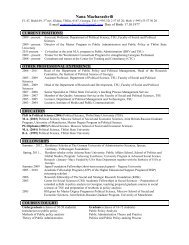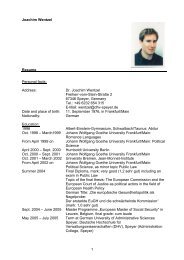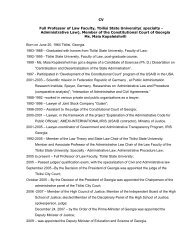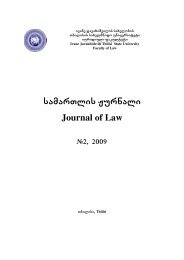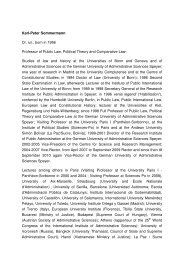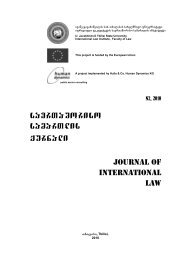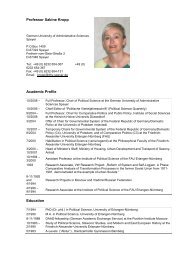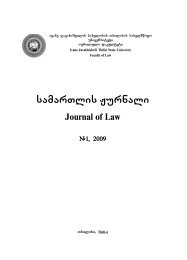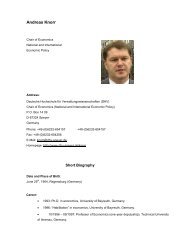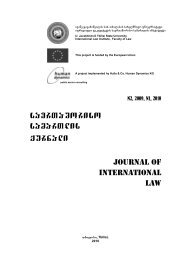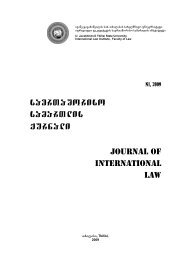Untitled
Untitled
Untitled
Create successful ePaper yourself
Turn your PDF publications into a flip-book with our unique Google optimized e-Paper software.
saerTaSoriso samarTlis Jurnali, #1, 2008 JOURNAL OF INTERNATIONAL LAW, N1, 2008<br />
istration, as common courts did not exercise<br />
control over administration and respectively<br />
the latter was left without any supervision.<br />
Ombudsman is defined as entrusted independent<br />
person who is authorized by a Parliament<br />
to protect rights of individual citizens<br />
and exercise parliamentary control over state<br />
officials, however he/she does not possess a<br />
right to alter decisions made by them.<br />
Since 1919 the similar bodies were introduced<br />
and incorporated into the legal control<br />
system in a number of countries throughout<br />
the world. Before 1919 the ombudsman institution<br />
did not exist anywhere but Sweden. In<br />
that year the institute was introduced in Finland.<br />
In a Rule of Law state tremendous importance<br />
is attached to organs carrying into effect<br />
legal and institutional guarantees for human<br />
rights protection – constitutional court and<br />
institution of ombudsman. After World War II<br />
the world community reached the conclusion<br />
that facts of human rights violation were hampering<br />
establishment of legal order throughout<br />
the world, and this led to the process of<br />
searching and creating both – international,<br />
as well as national mechanisms of human<br />
rights protection. By now in a diverse group of<br />
states institutions of constitutional control and<br />
ombudsman are being widely disseminated.<br />
There are more than 100 diversities of<br />
ombudsman institution in over 80 countries of<br />
the contemporary world, though each of them<br />
takes care of protection of human rights and<br />
freedoms in a respective state. The institute<br />
was launched in Denmark and Norway in 1953;<br />
however, in Norway it functioned as a martial<br />
ombudsman’s institution until 1963.<br />
In 1952 representatives of New Zealand –<br />
the Prosecutor General and a Deputy Minister<br />
of Justice of the country – attending an UN<br />
organized seminar on ombudsman institution<br />
were flabbergasted after listening to the report<br />
of the first ombudsman of Denmark Stefan<br />
Gurvich in Ceylon and a law introducing<br />
an institution of ombudsman followed, which<br />
was adopted on 7 September, 1962.<br />
Whyatt Report, produced by the England<br />
section of the International Justice Commission<br />
working on the crisis in the administrative<br />
court system also recommended introduction<br />
of ombudsman institution in Great Britain.<br />
Despite having many opponents in the state<br />
bureaucracy as well as lacking the support of<br />
the Prime Minister MacMillan’s Conservative<br />
Government, Wilson, who included the issue<br />
into his pre-election campaign program, won<br />
the elections and Law on Parliamentary Representative<br />
was adopted in three years time,<br />
in 1967.<br />
At the edge of 1960-70s the institution was<br />
being introduced into a number of US states,<br />
in 1973 – in France, in 1976 – in Portugal, in<br />
1981 – in Spain, in 1982 – in the Netherlands,<br />
in 1988 – in Poland, in 1995 – in Georgia. 1<br />
In international practice ombudsman is<br />
often called different names. In particular, it is<br />
called Mediator in France, Provedor for Justice<br />
– in Portugal, Public Defender, like in<br />
Georgia – in Spain, Commissioner – in Poland,<br />
etc. Despite such a variety of names the term<br />
“ombudsman” has maintained its particular<br />
position, as of international denominator of this<br />
mechanism of human rights protection.<br />
The experience proves that ombudsman<br />
institution is mostly demanded in cases when<br />
different institutions fail to exercise functions<br />
of controlling state authorities and additional<br />
protection of citizens’ rights from arbitrariness<br />
of an administration is considered necessary.<br />
Creation of ombudsman institution is closely<br />
linked with both – the theory of separation<br />
of powers, as well as contemporary development<br />
of society and broadening the scope of<br />
state and administrative activities. The latter is<br />
a cause of expansion of disagreement between<br />
state-administrative bodies and citizens. This<br />
is supported by a constant increase of number<br />
of people employed in state apparatus, great<br />
number of legal acts and regulations, information<br />
deficit over executive branch of the<br />
government in parliament, overloading administrative<br />
courts with proceedings, etc. In such<br />
a situation a citizen is constantly under the<br />
pressure of administrative and other bureaucratic<br />
institutions that causes citizen’s displeasure<br />
and distrust towards a state.<br />
Based on all the above mentioned it can<br />
be concluded that proliferation of ombudsman<br />
institution and its inclusion into political-legal<br />
systems of a number of countries is preconditioned<br />
with the state entering into all social<br />
spheres of life of a society, broadening state’s<br />
administrative functions, through state regulations,<br />
which strengthen a role of legislative<br />
184



